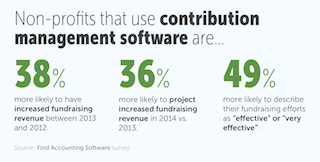Moving Beyond The “Don’t Mess with it If it Works” Mentality at Your Nonprofit

During my 14 years of working in the nonprofit industry, specifically a Private College Prep Catholic High School, I have found that it tends to be a slightly fragile technical community due to its very nature.
Working with a staff of volunteers of varying technical skill levels, while also running on shoestring budgets, tends to promulgate the mindset of “don’t mess with it if it works”. You know what I mean. But there is a slight error in that line of thinking as it restricts the progress that comes with adoption of new practices, techniques, and technology.
Technology investments should be considered a force multiplier and a necessary expense to maintain the vitality in connecting with and gaining donors and funding.
But how does one begin to promote technical or procedural change?
It begins with embracing the concept of change as a whole.
Many times it’s the nonprofit leaders who are responsible for promoting or stifling change. It’s much easier to prepare for and handle change if there is a leader at the helm who is comfortable with, and has confidence in, the need for change. I know that at the user levels there’s often a concern about not knowing how to use new technology or adopt new processes (which can oftentimes be handled with training), and weariness about the level of work required to take on this new system or process (which can be handled with a well-defined job definition). Having a leader who understands the root of this fear of change and how to overcome it is what makes change within an organization possible.
Getting motivated to fully embrace change is hard but not impossible.
Normally, leaders are so involved with leading that they lose track of the trench workers and are unfamiliar with their systems and processes. To fully embrace new technology the leader must become at least cursory familiar with their current state and what they want or need in order to make a change. Then, they must become fully knowledgeable about what that change will mean to the organization and to the people who will be expected to employ it.
Will this be easy? No.
It requires a bit of research and hard work to make this work. A keen knowledge level of any subject is what makes confidence and comfortability possible. As the leader, you will need to do the work to find the ROI and the time savings or procedural proficiency, which will make it a no-brainer to implement change.
How do you get all of this research done while still leading your organization?
Technical representatives and product managers: these people know their technology.
Working with them will make organizational change possible. You know your organization, but they know their products. After explaining to them your position and goals, they can provide you with the technical guidance. They can also answer questions you may not even knew you had.
Seeking help from subject matter experts is crucial when working to embrace new technology at your organization.
When your nonprofit makes the decision to embrace change through new technology, you’re empowering your organization to work more efficiently. And in nonprofit that means a lot. Every penny and every minute counts, so make the decision to be as productive and proficient as you possibly can. Embrace technology change today.

Important Facts About Nonprofit Technology:
- Revenue growth is not assured. 47% of nonprofits generated the same or less revenue in 2013 compared to 2012.
- Fundraisers believe in technology, but often lack it. 4 out of 5 fundraisers feel that better technology leads to fundraising success. But only 1 in 3 say they currently have the tools they need to be effective.
- Leveraging the web matters. Nonprofits who accept online donations are 24% more likely to have increased fundraising revenue last year. Tactics such as blogging and sharing video content increase the effectiveness further.
- Diversification is key. Using a greater variety of software, channels, and payment methods correlates strongly with fundraising success. The most successful fundraisers used 3x as many web communication methods on average.
- There is an emulatable technology profile of a successful fundraiser. 83% of the fundraisers who achieved it describe their fundraising as either “effective” or “very effective.”
For access to study statistics, charts, raw data, and the video report, check out the 2014 Fundraising Technology Trend Study
